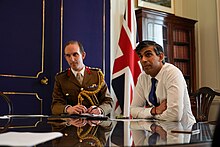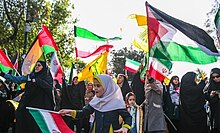April 2024 Iranian strikes against Israel
[26] Israel said that the coalition, whose defensive efforts were codenamed Iron Shield,[27] destroyed 99 percent of the incoming weapons,[28][29][30] most before they reached Israeli airspace.
[33][34][35] In Israel, a 7-year-old Israeli Bedouin girl was struck and injured by part of a missile, and 31 other people either suffered minor injuries while rushing to shelters or were treated for anxiety.
[39] Iran's attacks drew criticism from the United Nations, several world leaders, and political analysts, who warned that they risk escalating into a full-blown regional war.
[44] On 1 April 2024, Israel bombed the Iranian consulate annex building next to the Iranian embassy in Damascus, Syria, killing 16 people, including a woman and her son, and Brigadier General Mohammad Reza Zahedi, a senior Quds Force commander of the Islamic Revolutionary Guard Corps (IRGC), and seven other IRGC officers, in addition to six other militants belonging to Hezbollah and other Iran-linked militias.
[63] On the evening of 13 April 2024, Iran launched a drone and missile attack on Israel, targeting—among other unconfirmed trajectories—sites in the Israeli-occupied Golan Heights and Arad region and two airbases in the Negev desert.
[29] According to IDF spokesperson Daniel Hagari, approximately 350 rockets were launched at Israel from Iran, Iraq, Lebanon, and Yemen, also noting that the attack consisted of 60 tons of explosive materials.
[93] At approximately 2:00 a.m. local time on 14 April, explosions were heard in Jerusalem, while air raid sirens sounded across Israel, the West Bank, and the Dead Sea.
[103] According to The Wall Street Journal, Gulf states such as Saudi Arabia and the United Arab Emirates shared intelligence, which included radar tracking information, with the U.S. and Israel prior to Iran's drone attack.
[93] General Michael Kurilla, the head of United States Central Command (CENTCOM) went to Israel on 11 April, to coordinate air defenses.
[112][113] Royal Air Force Typhoon fighter aircraft shot down an unspecified number of Iranian drones, as confirmed by British Prime Minister Rishi Sunak.
[117] The Wall Street Journal, citing anonymous French officials, reported that France deployed naval assets to assist Israel.
[124] Iran claimed that the saturation tactic using drones managed to defeat the Israeli air defense and damage the bases used in the attack on the Iranian consulate.
[126] A senior U.S. official stated that five Iranian ballistic missiles struck the Nevatim Airbase, causing damage to a C-130 transport aircraft, an unused runway, and empty storage facilities.
[129] IRGC commander Major General Hossein Salami called the attack "more successful than expected" and threatened retaliation for any Israeli counterattack.
[138] The effective interception has led to an increase in the stock prices of Israeli defense firms, such as Elbit Systems, Aerodrome Group, NextVision, and Aryt Industries.
[147] The Intercept reported that American forces "did most of the heavy lifting responding to Iran’s retaliation for the attack on its embassy in Damascus", shooting down more drones and missiles than Israel.
[151] According to CNN, the attack by Iran was "planned to minimize casualties while maximizing spectacle", and noted that Iranian drones and missiles went past Jordan and Iraq, both with U.S. military bases, and all the air defenses before penetrating the airspace of Israel.
[153] John Bolton, however, called the attacks "a massive failure of Israeli and American deterrence"[154] and described Biden's disapproval of a possible counterattack as an embarrassment.
[155] An operational analysis by the Institute for the Study of War (ISW) concluded that the attack was likely intended to cause significant damage below the threshold that would trigger a massive Israeli response.
It was dependent on U.S. intelligence for the timing of the assault, for the location of many of the firing positions and on U.S., British and French assistance to help shoot down the incoming munitions".
[169] On 14 April, Jordanian Prime Minister Bisher Khasawneh stated during a cabinet meeting that any regional escalation would lead to "dangerous paths", adding that all parties involved need to de-escalate.
[170] On the same day, the country's Foreign Affairs Minister Ayman Safadi stated that Jordan would take "all necessary measures" to protect its sovereignty and security and that it will tackle threats facing its citizens.
[173] Safadi also added that Jordan would respond in the same way whether the threat came from Israel, Iran or any other country, and noted that the continuation of the Israel–Hamas war and instability in the West Bank would lead to further conflict, calling for a two state solution.
Supporters of the retaliatory attack also demonstrated in Isfahan, the burial place of Mohammad Reza Zahedi, and in Kerman next to the grave of Qasem Soleimani, who was killed in a 2020 US drone strike in Baghdad.
A protest leader characterized the strikes as a response to Israeli airstrikes in the region, while Melissa Lantsman, a member of parliament, said that the chants showed "It was never about a ceasefire".
[181] One of the first leaders to respond to the attack was British Prime Minister Rishi Sunak, stating: "The UK will continue to stand up for Israel's security and that of all our regional partners, including Jordan and Iraq.
[184] U.S. President Joe Biden shortened a planned visit to Delaware and returned to the White House to meet with national security officials.
[190] Biden told Israeli Prime Minister Benjamin Netanyahu that the United States would not back Israel in a possible future counterattack against Iran.
[191][186] U.S. Defense Secretary Lloyd Austin asked Israel to give the United States advance notice if they planned to attack Iran.
[197][137] On 16 April, Israel, the United States, the Netherlands and other countries called on the international community to impose sanctions on Iran's missile program.




